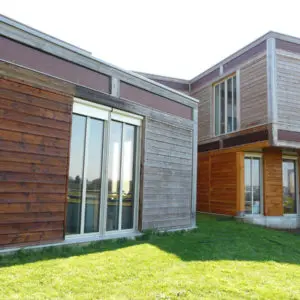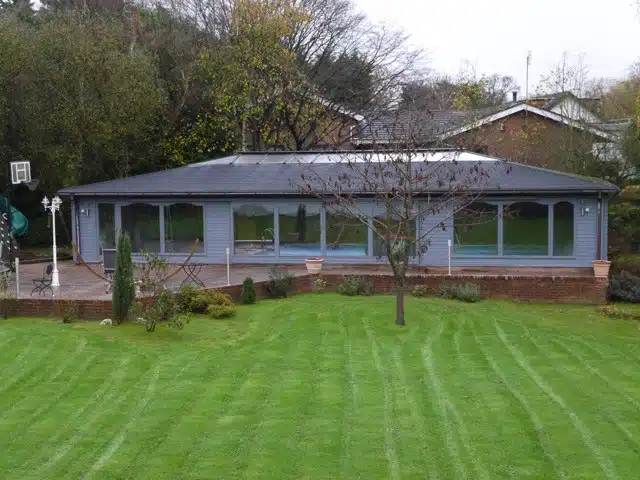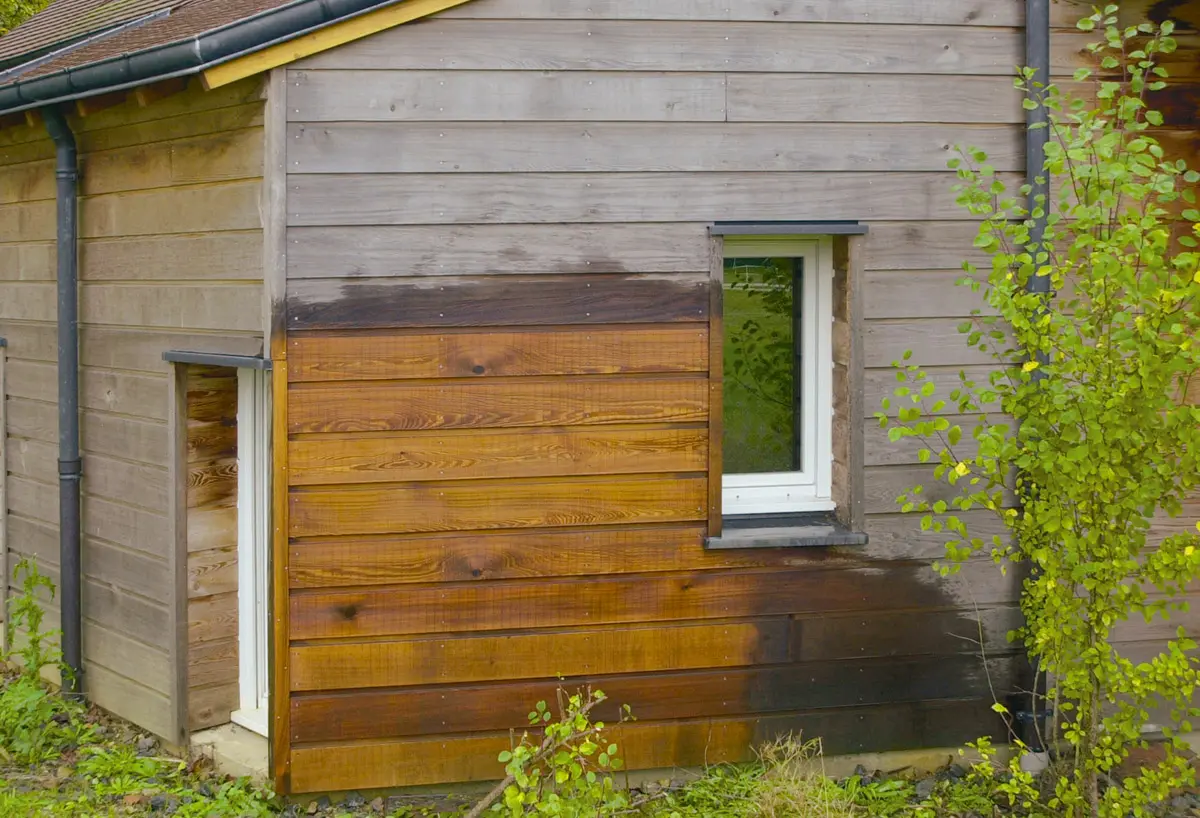The recent surge in popularity of wood cladding is not only to do with the opportunity of great effects it gives us to create. But, timber cladding is also extremely easy to maintain and if properly looked after, can last for many years.
So, what exactly is involved in protecting your wood cladding?
Step 1. Remove any existing coatings
If your cladding has had a coating previously applied, you will need to remove this before applying your desired finish.
Use something like Aquanett which is a solvent-free wood oil remover, it can be used to remove any old oils that have been applied to your cladding, including teak oil.
Aquanett will help you to return your wood to its natural state and as it has a gel-like consistency, it’s great for applying to vertical surfaces, without the excessive dripping and mess that is associated with a liquid oil remover. It also works to prepare your wood for its new coating, by improving adhesion and penetration. These are compromised with a previous coating on the surface. Aquanett is also suitable for environmentally sensitive areas.
If your wood cladding is covered in paint, then you will need to use a wood paint stripper such as Dilunett. Dilunett can strip up to 8 coats in one application. Again, it has a gel-like consistency, so it’s ideal for vertical surfaces.
Step 2. Neutralise your wood
If your wood doesn’t have any pre-existing coatings, you can skip step 1 and move straight to this step.
It’s important to prepare your cladding before applying any finishes.
Net-Trol is a non-aggressive wood cleaner, colour restorer and neutraliser and will lighten and restore your wood’s natural colour without bleaching it. Harmless to shrubs and plants, it works in just 15 minutes.
If you’ve used a stripper, such as Aquanett, Net-Trol is also required as a neutraliser. This is essential before you use a finish as it stops the active ingredients in the strippers.
Step 3. Finishes to suit your taste
One of the great things about timber cladding is that you can finish it in a number of different ways.
The three main finishes we will discuss are:
- Water-based Finish
- Opaque Coloured Finish
- Saturating Wood Oil Finish
3.1 How to protect your wood cladding with a water-based finish
Water-based penetrative products, such as Aquadecks, are typically seen as the most environmentally-friendly products to use to protect your wood cladding.
One of the main benefits of using Aquadecks to protect your wood from warping, splitting and cracking is that, unlike other products, it can be applied to your new wood cladding without having to use Seasonite and waiting a year for your wood to weather.
Aquadecks can be applied to both new and weathered wood and if applied correctly will not peel or flake. It’s a great choice if you want to accentuate the natural look of your timber.
It works by saturating, penetrating and stabilising the wood, to minimise any damage and results in a long-lasting, weather-resistant finish.
What tools do I need?
To apply Aquadecks, you can use a brush, roller or airless sprayer.
How to apply Aquadecks to your wood cladding
As Aquadecks is applied wet-on-wet, it is very quick and easy to apply.
If your wood cladding is new, you will need to remove any trace of mill graze (which can prevent Aquadecks penetrating) by applying Aquanett, a solvent-free, quick-working wood oil remover.
If your wood is already weathered, you should clean your wood with Net-Trol.
Make sure your wood is dry before applying Aquadecks (this can take around 48 hours after Net-Trol application).
- Mix Aquadecks thoroughly before and during application.
- Working from top to bottom, in the direction of the grain, liberally apply your first coat of Aquadecks. You can do this with a brush, roller or airless sprayer.
- Leave for 15-20 minutes (or when your first coat starts to lose its wet look). Then apply a second coat.
- If your wood cladding is particularly porous, you may need to apply a third coat. You should do this after another 15-20 minutes.
- 20 minutes after applying your final coat, brush out any ‘puddles’ where Aquadecks hasn’t been absorbed.
Aquadecks is meant to be a penetrative product, so none should ‘sit’ on the surface of your wood cladding. If you choose to spray Aquadecks onto your cladding, always brush or roll back to improve penetration, coverage and uniformity of colour.
As Aquadecks should be applied wet-on-wet, it should not be allowed to dry in-between coats. We recommend you work in sections that you can complete in around 15 minutes. This is so you can go back and re-coat before your cladding is able to dry.
Maintenance
Maintenance is simple when using a water-based penetrative product such as Aquadecks – just clean with Net-Trol to remove any built-up dirt and apply a maintenance coat, as needed. No sanding or stripping required!
If you’re looking for a water-based, semi-transparent matt finish that will enhance the natural beauty of your wood, rather than covering it, Aquadecks is a good choice. It also provides advanced UV protection, to prevent your wooden cladding from fading.
For added longevity and protection, especially if you live in a harsh environment (such as where there is intense heat and UV exposure, or particularly rough weather), Tropitech is a good ‘all in one’ water-based, semi-transparent finish, which will help your wood cladding to resist moisture, rot and decay. Tropitech also contains a fungicide that resists mildew. As Tropitech delivers long-lasting protection against UV damage, it slows down the ageing process of wood.
Tropitech bonds both ‘in’ and ‘on’ the wood and serves not only to protect your wood cladding but also to enhance it.
3.2 How to protect your wood cladding with a coloured opaque finish
Applying a coloured opaque finish on your cladding is a great way to protect it, whilst making it look great.
By using a good quality ‘all-in-one’ product, such as our Solid Colour Stain, you can ensure that maintenance is kept to a minimum. Top-up coats will only be required every few years – or sometimes even longer.
Our Solid Colour Stain provides your cladding with a strong, flexible film. It moves with the wood and will not flake or peel. It will ensure that your wood is protected against damage caused by UV rays and moisture. By using a high-quality product, you will find long-term protection with minimal maintenance.
What do I need to know?
Containing Owatrol’s Emulsa-Bond, our Solid Colour Stain has excellent adherence, minimising the need for lengthy preparation and priming.
Solid Colour Stain can be applied to both new and weathered wood cladding, although new wood should be treated with Seasonite and left to weather before application and weathered wood should be cleaned with Net-Trol (and then left to dry). Alternatively, if you want to finish your wood straight away you can remove the mill glaze and then finish your new wood with SCS.
If your timber cladding has been previously coated, you will need to strip it with Dilunett or Aquanett and then neutralise with Net-Trol.
With 35 shades to choose from, you can choose something traditional or opt for a bright colour or statement look.
If you’re feeling brave, you could even use multiple colours to create striking looks across different sections, such as a ‘stripe effect’, achieved by painting alternate pieces of wood in two or more different colours.
Our Solid Colour Stain is guaranteed against peeling and flaking for 15 years on vertical surfaces, such as wood cladding when applied correctly to bare wood.
How to apply a Solid Colour Stain
Applying a Solid Colour Stain in a shade of your choice is very simple:
- Using a roller, brush or sprayer, apply a coat of Solid Colour Stain, avoiding heavy application.
- Allow this coat to dry for 3-4 hours.
- Apply a second coat of Solid Colour Stain.
- If using a sprayer to apply your Solid Colour Stain, make sure to brush or roll back immediately after application. This will ensure that there is even coverage and penetration, as well as uniformity of colour.
Clean all of your tools with soap and water whilst they’re still wet. You will need to use paint stripper to remove excess paint if you have left your tools to dry.
As with all of our products, make sure you follow the instructions and safety precautions stated on the tin.
3.3 How to protect wood cladding with saturating wood oils
Saturating wood oils are a great way to achieve long-term protection for your cladding. They work by penetrating deep into the pores of the wood and effectively saturating it, to prevent any moisture from entering your cladding.
As saturating wood oils do not form any type of film on the surface, they will not crack, peel or flake and will work to protect your wood cladding from within, preventing moisture ingress and damage caused by UV exposure.
These penetrating oils come either clear or tinted and are made to enhance the natural look of your wood cladding, rather than to cover it.
Here at Owatrol, we recommend our customers protect their cladding with Textrol saturating wood oil. One of our flagship products, Textrol is available in 7 different colours, including rustic oak, redwood tone and clear.
What tools will I need?
You can apply Textrol and our other saturating wood oils with a brush, roller or garden sprayer.
How to protect your wood cladding
If your timber cladding is new, you should first treat it with Seasonite and then leave it to weather for 6 to 12 months, so that Textrol can properly penetrate your cladding.
Before applying Textrol, we recommend that you clean your wood and restore its natural colour with Net-Trol. Any previous coatings on your cladding will need to be removed with a stripper, such as Dilunett for opaque finishes and stains or Aquanett for wood oils, depending on whether your wood was previously painted or oiled. You will not need to remove any previous coatings of Textrol.
To apply Textrol:
- Ensure your wood is dry.
- Apply the first coat of Textrol with your brush, roller or garden sprayer. Leave it for 15-30 minutes for it to be absorbed into the wood. Make sure that you don’t let the surface of the wood dry between coats. This could prevent the next coat from penetrating the wood.
- Apply another coat after 15-30 minutes. Repeat this until no more Textrol is being absorbed into the wood.
- Brush or rub off any excess oil to avoid shiny spots.
Make sure that you work across your wood cladding in sections when applying Textrol. This is so you are able to go back to your initial sections and apply their next coat before they are touch dry.
Clean your tools with white spirit immediately after use. If they dry, you will need to remove the Textrol with paint stripper such as Dilunett.
You should also ensure to properly discard of any cloths or other rags that you’ve used. Please follow the instructions on the tin.
If you would prefer a single coat application, we’d recommend using Textrol HES.
D1 Pro is the best choice if your wood cladding is made of hardwood. If you would like to protect your wood cladding from water damage but keep the grey, weathered look, we would recommend using H4 Wood.
Benefits of saturating wood oil
One of the main benefits of Owatrol’s saturating wood oil is that it is easy to maintain. Maintenance coats are quick and simple and no sanding or stripping is required.
Saturating wood oils not only look great and enhance the natural wood of your wood cladding but also help to protect it from moisture and UV damage.
We hope you found this post on how to protect your wood cladding helpful. If you have any other advice or top tips, please feel free to leave them in the comments below. We love hearing from you!
You can also follow us on Twitter, Facebook, Instagram or Pinterest at @OwatrolUK or find us under the hashtag #OwatrolUK














I want to treat new softwood cladding for external buildings how do I go about it
Hi there Mick,
If you have any questions not covered in our blog post, or questions about our products, please give us a call on: 01582 592707
All the best,
The Owatrol Team
Hi,
We are planning to paint 300m2 of oak cladding with Bedec Barn Paint.
As the wood is denatured what product/system would you advise to prepare the wood so cell structure is opened up to accept the paint.
Thankyou. Nigel
Hi there Nigel,
If there is no previous coating on your cladding, then the best way to prepare your wood is to use a product such as Net-Trol wood cleaner and brightener: https://www.owatroldirect.co.uk/product/net-trol/
It restores greyed and weathered wood to its natural colour without damaging the wood’s fibres and effortlessly removes both surface and ground-in dirt leaving the wood looking bright and vibrant.
It is fast-acting and can restore the original colour of your wood surface in as little as 15 minutes with no sanding required.
If there is a previous coating on the wood, this should be removed with one of our stripping products such as Prepdeck, Dilunett, Aquanett or DSP800.
If you have any further queries, please feel free to give us a call on: 01582 592707 or send us an email to: sales@owatroluk.com where we will be able to assist you quicker.
All the best,
The Owatrol Team